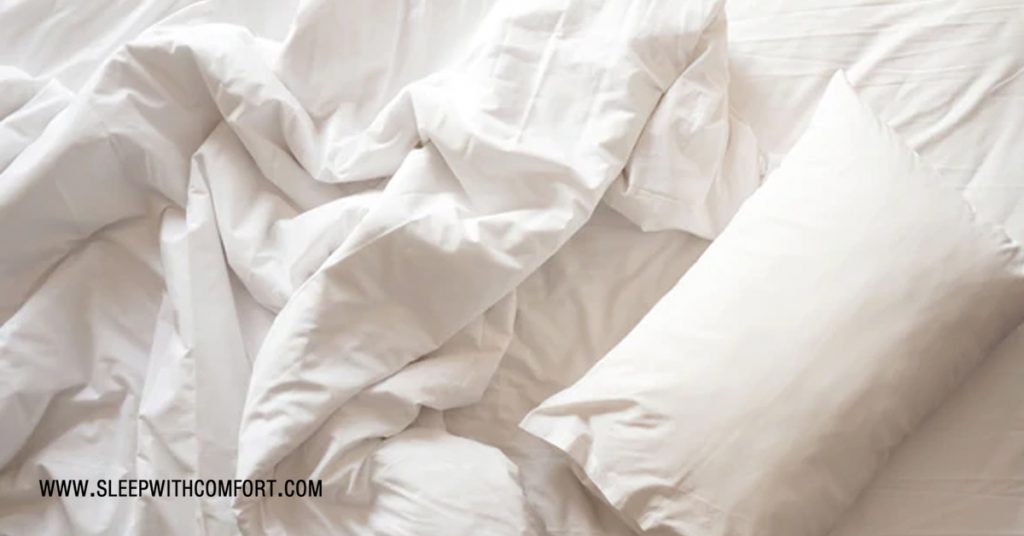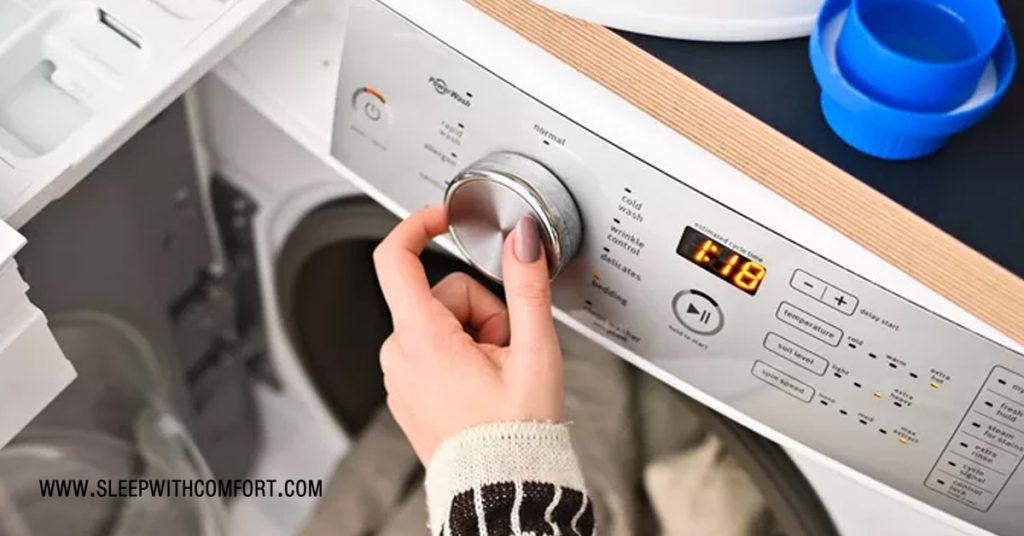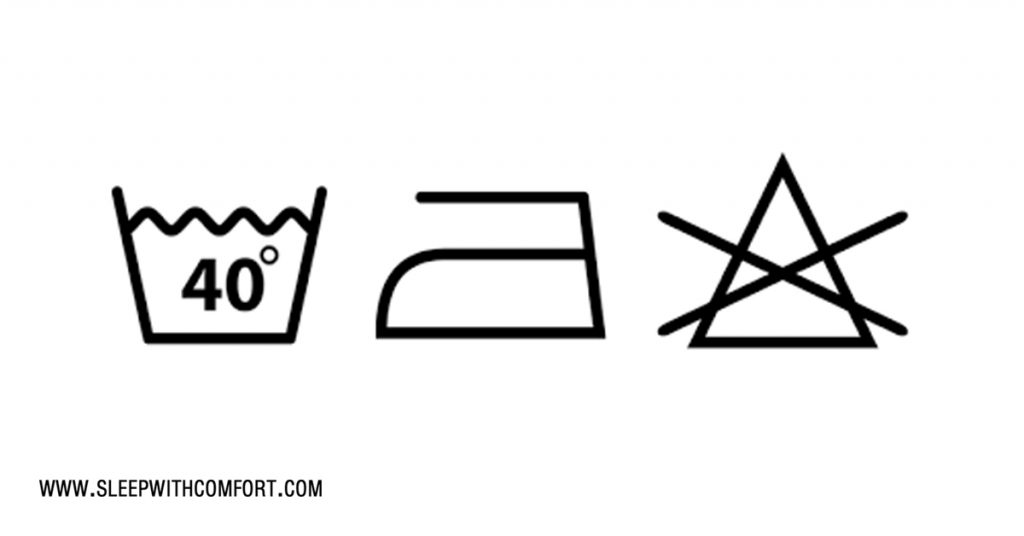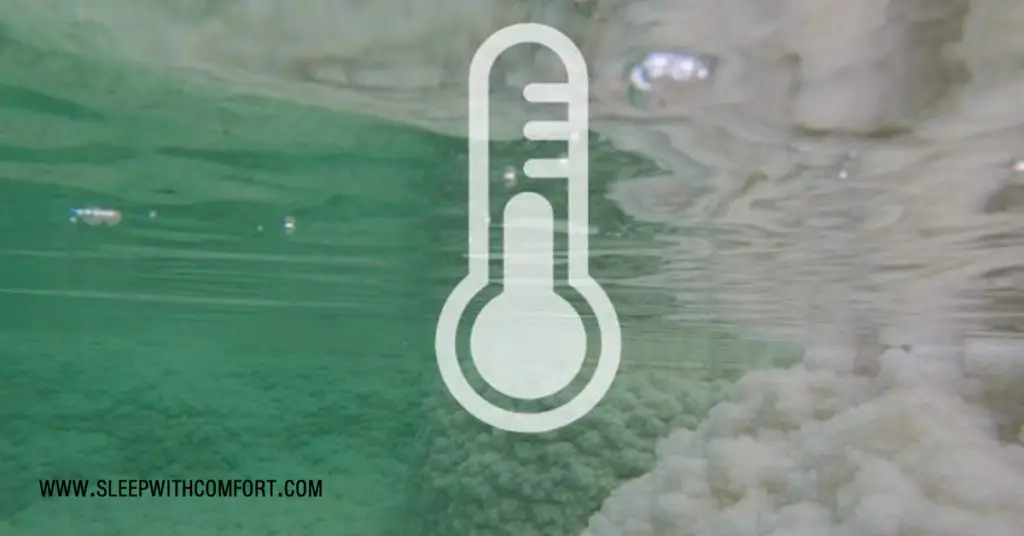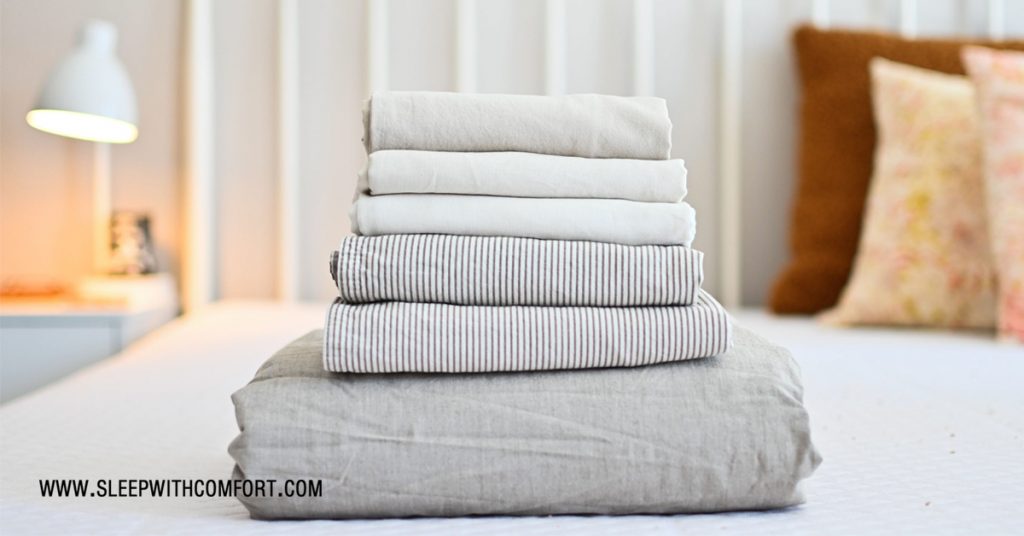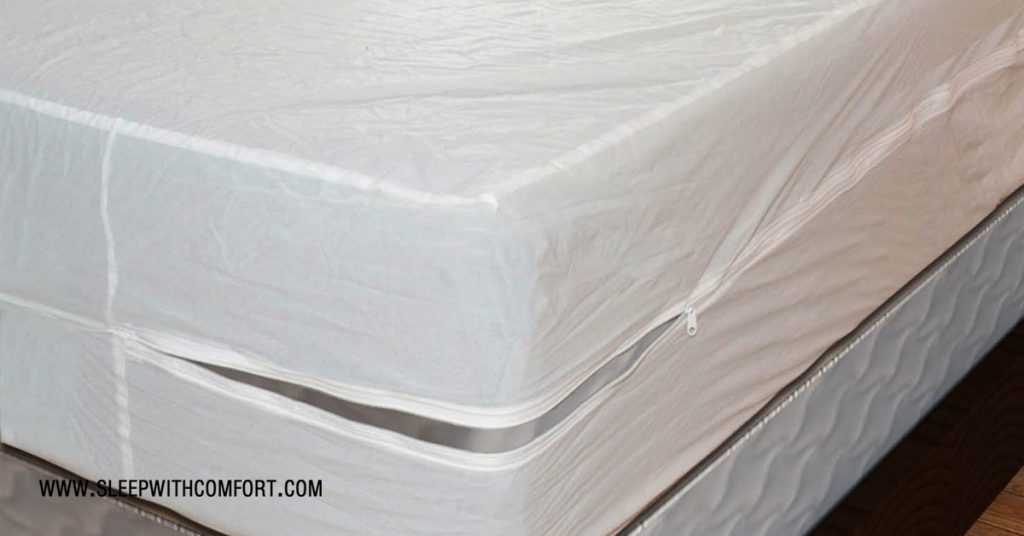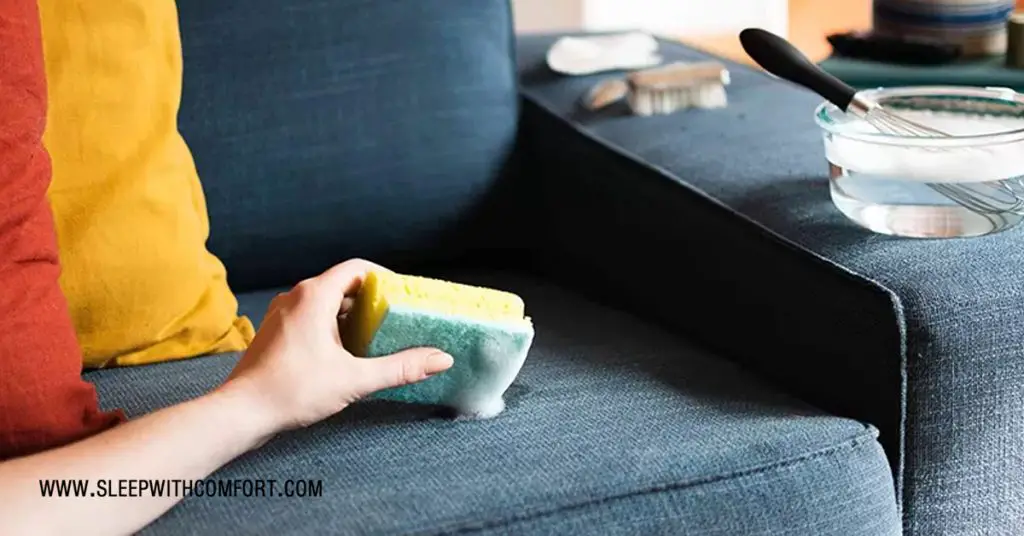Disclosure :Sleepwithcomfort is reader-supported. When you buy through links on our site, we may earn an affiliate commission.
Nocturnal enuresis is another term for bedwetting. It occurs when a person unintentionally produces pee while sleeping. It is most frequent in youngsters, although it can also happen to teenagers and adults. It is pertinent for everyone to know, How to clean sheets after bedwetting.
It is most likely a symptom of an underlying condition in adults, such as diabetes, constipation, stress, or urinary tract infection. Wetting the bed is very typical in children, teens, and adults.
Adults who bed-wet should see a doctor if the wetting indicates another condition. So, how do you clean up after a bedwetting incident?
If you discover urine discolourations on bedding, they can be unexpected and annoying. If your pet or a potty-training toddler has had an accident, you could be daunted by the arduous chore of washing urine from bedsheets. So you must equip yourself with knowledge about, How to clean sheets after bedwetting?
You should remove the urine on your sheets as soon as possible. Untreated urine will cause mould and germs to grow in your bedsheets, making them difficult to remove.
Cleaning and drying bedsheets include the following steps:
Step One:
To begin, blot the sheets using a towel or cloth. I used a cloth, a dry towel, or even a paper towel to blot excess moisture from the sheets. Try to absorb as much liquid as possible with a dry towel or cloth.
You can remove any urine discolourations in the bedding with a stain remover. Use professional-grade stain removers to eliminate the risk of odours and stains. Spray the urine-affected areas as well if the urine has evaporated. As it is an integral part of the process of, How to clean sheets after bedwetting?
It’s important not to agitate the spots. Rubbing the stain will cause the liquid to sink even deeper into the mattress than it has already.
Step Two:
Wash your bedding in boiling water. You can wash your bed sheets in hot water with regular detergent. It will aid in the elimination of microorganisms caused by urine.
Load the washing machine with the sheets:
After that, you should remove your bed sheets and throw them in the washing machine. This aids in the removal of stains and odours from the bedding as a part of How to clean sheets after bedwetting.
If the odour is too strong, add vinegar to them. Vinegar can assist with odours. If you’re still concerned about stains, try saturating the spot with hot water and some washing detergent. After that, you can clean the sheets as usual because you know how to clean sheets after bedwetting?
Step 3 | Dry up the bedsheets:
If there is no odour, you can now dry clean your bedding by gently putting them in the dryer. If the sheets still smell, wash them with vinegar again and dry them in the dryer.
When the sheets are dry, remove them from the dryer and fold them neatly before using them.
Sheets and mattresses are used together; thus, cleaning them goes hand in hand as a part of How to clean cleaning bedwetting?
Before you go to bed, check your bedsheets. Avoid dry cleaning bed sheets if there is any discolouration after washing. Drying the sheets may cause the discolouration to become permanent. It would help if you rewashed your bed sheets until the discolouration had disappeared.
Step 4:
It’s crucial to dry the bedsheets on the dyer’s maximum setting. When drying the bedsheets, use high heat to destroy any leftover bacteria. The bedsheets could be scented with a dryer being a part of How to clean sheets after bedwetting.
It’s enough to make you lose sleep just thinking about bugs in your bed and blankets. However, unless you take steps to eliminate bed bugs from your sheets, the problem will become worse.
Because the indicators of bud infection are difficult to spot, you should act quickly. You must seek them out immediately so that treatment can begin. You can eliminate Bed bugs in sheets by hiring an exterminator or laundering. Toss the sheets into a plastic rubbish bag.
It would help if you then contained sheets in a second rubbish bag. Straight to the laundry machine with the sheets. Laundryman should know, How to clean sheets after bedwetting?
Use hot water to wash, and then dry on the highest setting. After placing your sheets in the machine, ensure that the inner bag is discarded.
Handwashing bed sheets:
Hand washing the bedsheets is undoubtedly appropriate, although this method is probably best used when the cloth isn’t very unclean. When your bed sheet has a loose weave, it is also recommended to hand wash it. This handwashing practice prevents the fabric from pulling.
Some textiles, such as silk or satin, benefit from hand washing since they are too delicate to be washed in a machine.
Handwashing will almost probably extend the item’s life more than washing it on the gentle cycle, which is also an option for How to clean sheets after bedwetting. The same general rules apply when washing bed sheets by hand, like washing in lukewarm water using only a light detergent.
Also, make sure the detergent is completely removed from the sheet before drying it.
Place your bedding in a clean basin or sink filled with lukewarm water and a mild detergent. Gently swish the sheet in the water with your hands for a few minutes. Scrub, wring or twist the fabric to no avail. Remove the sheets from the sink after giving them a thorough swirl.
Drain the soapy water, rinse the sink, and replenish with lukewarm water. Rinse your bedsheets and repeat until the water is soap-free.
Washing bedsheets in vinegar softens, brightens, and disinfects them. You can whiten, disinfect, and deodorize your garments without using chemicals as a part of, How to clean sheets after bedwetting.
Vinegar is safe to use in high-efficiency and ordinary washers, and it is a suitable environment and septic system.
Choose distilled white vinegar when buying vinegar for your laundry. It is inexpensive and free of tannins, which can stain clothing.
Grease builds up on bedsheets due to normal sweating, natural skin oils, and body and hair care products.
Make sure your skin and hair are clean and free of cosmetics and lotions before going to bed as it
can help keep bed sheets cleaner between washings; nevertheless, caring for bed sheets regularly will help reduce the amount of grease used to clean the sheets.
How to Machine-Wash Bed Sheets:
You should wash the fabric in the hottest water setting on the washer. Cotton can withstand hot water, although polyester blends benefit from warm water. Germs and dust mites thrive in sheets, and hotter water kills them.
Ensure that the sheets are kept separate from other materials. The bedsheets become entirely clean if the washing is not overloaded. When sheets are washed in the same cycle as towels or other coarser fabrics, the fibers degrade, and the fabric wears out faster.
To wash the sheets, use the gentle cycle on your washing. Avoid wrapping bed sheets over the agitator while using a top-loading washer because this can cause them to tear or even strain.
To avoid the worst wrinkles, tumble dry on low heat and remove the bedsheets as soon as possible. Make sure the bed sheets don’t get too dry.
Because bed sheets take up a lot of space to clean, don’t cram too many into one load. Wrapping bed linens around the agitator will cause wrinkles and tears.
To avoid other items becoming tangled in your bed linens, wash them separately. If you wish to wash other items with your bedsheets, make sure they are of the same colour and are lightweight.
Washing Instructions:
While you can usually wash cotton bed sheets on any cycle, double-check. Always read the washing machine directions on the care label first.
Select the cycle that best suits the level of dirt on your bed sheets: heavy-duty for heavy soil and stains, regular for light soil. If you over-wash your bedsheets, they will wear out faster.
The temperature of water:
Cotton bed sheets in light and white colours wash well at any water temperature. However, wash your bed linens on a warm/hot cycle during the flu and cold season to sanitize them.
It will also aid in the reduction of allergies. To preserve darker coloured bed sheets from fading, wash and rinse them in cool water.
To get rid of bed bugs and their eggs, wash cotton sheets once a week at 60°C.
But, especially if the bed sheets are not made of cotton, check the wash labels to make sure it’s okay to wash them at that temperature. It would help if you got a high-quality washing machine.
How to keep bed sheets clean without washing them:
Prewash bed linens with vinegar and baking soda before using. It is critical to begin the wash with 1 cup of baking soda.
Add 1 cup of white vinegar to the rinse cycle after that. Following this wash, the sheets will be ready to use.
Bed sheets you should wash Bedsheets once a week. Dry the bedsheets on a clothesline that is not in direct sunlight.
You must use a clothes dryer if you cannot dry them outside. Setting the dryer to low heat reduces the damage caused by high temperatures.
To avoid creases, do not over-dry the bed linens. When the sheets are ready, Remove and fold them as soon as they are dry—also, hand-press the bed linens to remove any wrinkles.
Toss a wet rag in your dryer and dry the sheets for additional 5–10 minutes if you forgot about them in the dryer.
After cleaning the sheets and mattress, we must now safeguard the bed from future damage. You may accomplish this in three simple steps:
• Getting a plastic mattress cover:
Use a plastic mattress cover to keep liquid out of your mattress. Local hardware stores sell plastic mattress covers.
The liquid will not leak through the mattress cover if you wet the bed again.
It’s beneficial for folks who wet the bed frequently. However, it is crucial to stress that being a frequent bed wetter is not a problem.
• Use waterproof protection:
If you don’t like the sound of a plastic mattress cover, you can choose a washable protector made of breathable textiles.
Before spreading your bedding, place the washable protection over the mattress and remove it as needed to wash.
Washable protection cannot make any noise and be slightly comfier than a plastic cover. Washable protectors are available at local hardware stores and online.
• Choose easy to clean fabric:
Purchasing a simple fabric is the third method of bed protection. Instead of using the plastic mattress cover or the washable protector, you can choose bedding that is easy to clean.
Use the bedding, especially if you’re going to wet the bed again. Simple fabric is helpful in children’s beds.
Cotton bedding, for example, is stain-resistant and easy to clean. Finally, after the bed has been made moist, it is critical to clean your bedding correctly.
Conclusion:
To summarize, after the bed has been made wet, it is critical to clean your sheets properly, so you must know, How to clean sheets after Bedwetting. While we’re on the subject, it’s worth noting that wetting the bed is quite typical among children, teenagers, and adults alike. One should seek medical assistance if any other problem arises.
FAQs:
After wetting the bed, how do you clean the sheets?
Spray the infected area liberally with a mix of two parts cold water, one part vinegar, and a little bit of detergent. Allow 10 to 15 minutes for the solution to sit before blotting with a clean, dry towel to remove as much liquid as possible.
Why is it necessary to clean your sheets?
Fungi, bacteria, pollen, and animal dander are typically found on sheets and other bedding; if you are not cleaning them regularly, it will expose you to them. Bodily secretions, sweat, and skin cells are among the other substances found on sheets.
What is the most crucial aspect of a childcare cleaning routine?
The most efficient and cost-effective way to eliminate germs from various surfaces in the childcare setting is routine cleaning with detergent and warm water. It also cleans surfaces of filth and oil.
How do you wash your bedding?
As is customary, wash bedding in cold water. You should use the “normal” cycle (also known as “regular” or “permanent press”). Avoid overcrowding the washing machine; sheets require space in the drum for water and detergent to thoroughly enter the fibers.
After wetting the bed, what do you do with a mattress?
Sprinkle on some baking soda once you’ve cleaned up the area. Allow it to dry overnight (the longer, the better – aim for around 10 hours!). The following day, vacuum up the baking soda. Your child’s urine should no longer have a stench.

